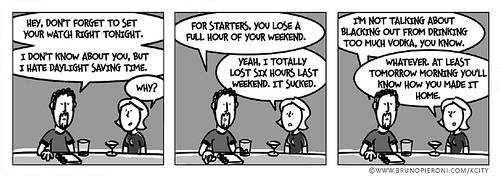
Daylight Savings Time: Energy Waster
Guest post by Brian Clark Howard, editor at The Daily Green

Cartoon from “K City” by Bruno Pieroni
Growing up in Central Indiana, daylight savings time seemed foreign and exotic. My friends and I were aware that we were the butt of jokes around the country for being one of only two backwards places in America that didn’t observe the phenomenon (part of Arizona being the other at that time). Part of the year we were on “New York City time,” and part of the year it was “Chicago time.” (To make matters worse, 15 of Indiana’s 92 counties actually did observe daylight savings.)
The biggest effect of not observing DST (daylight savings time) seemed to be which TV Guide schedule one had to look at to make sure you didn’t miss your shows. This was fine, until I moved away from Indiana, and I was perpetually perplexed about what time it was back at my parents’ house, making calling them a crap shoot.
People always said that the reason Indiana didn’t observe DST was because it was a farm state, and farmers didn’t like to switch times, given that they were accustomed to getting up at the ass crack of dawn to milk Bessy, rob the chickens of their nightly labors and putter about the cornfields. How the good farmers of Iowa managed to be convinced to go along with the time change was never explained to me.
Turns out Farmer John isn’t the only one who has a beef with daylight savings, in addition to computer programmers and those who calibrate elaborate machinery. There has long been a heated debate about whether the practice saves energy or wastes more.
Interestingly, the 2006 adoption across all of Indiana of DST gave researchers a unique opportunity to put the energy use theory to test. A professor and grad student at UC Santa Barbara found that residential energy use in Indiana went up by 1 to 4 percent after the switch to daylight savings time, costing ratepayers an additional $8.6 million annually.
Why? The researchers found that even though people did need to use lights less in the evenings, that was more than offset by people running the heat more in the resultant cooler mornings, and running their air conditioners more in the evenings when it was hot. When parts of Australia adopted DST in 2000, energy consumption stayed about the same, although increasing morning loads drove prices up. A 2007 simulation in Japan predicted that overall energy use would rise if Osaka switched to DST.
As a night owl who works a 9-5 (more like an 8:30-6:30 or 7), I really like daylight savings, because it is actually still light out many days when I head home. It helps mark a nice change from the long winter of leaving for work when it’s dark (I have a long train commute) and stepping out of the office and walking through Times Square when it’s dark.
Retail (people shop more) and sporting goods and events (duh) companies love DST, while theaters, TV broadcasters and yes, farmers, oppose it. Interestingly, daylight savings means higher gas consumption, although it may decrease traffic accidents and possibly some crimes. The jury is still out on whether it is good for health (decreases seasonal depression disorders and promotes exercise!) or not (increases skin cancer!).
Regardless of whether you come in favor of DST or not, you don’t have much choice in most of the country. Don’t forget to turn your clocks forward an hour, as it begins at 2 am on March 9. It might also be a good idea to adjust your thermostat (you should have an automatic!) and any timers on lights. Why pay for energy you don’t need, and pollute more?
The famously wise Benjamin Franklin had proposed adjusting the clocks with the seasons precisely to save on candle wax and other resources. So honor that spirit by adjusting your consumption appropriately.





